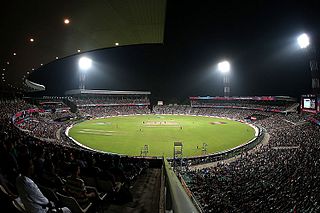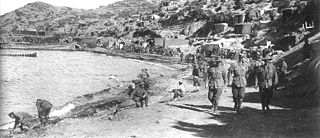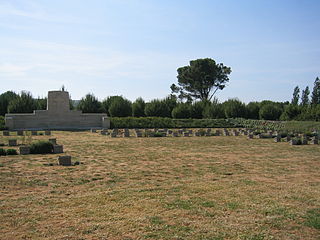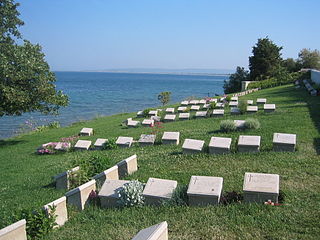Shell Green Cemetery is a Commonwealth War Graves Commission Cemetery from World War I in the former Anzac sector of the Gallipoli Peninsula, Turkey. The battles at Gallipoli, some of whose participating soldiers are buried at this cemetery, was an eight-month campaign fought by Commonwealth and French forces against Turkish forces in an attempt to force Turkey out of the war, to relieve the deadlock of the Western Front (France/Belgium) and to open a supply route to Russia through the Dardanelles and the Black Sea. [1]
The Commonwealth War Graves Commission (CWGC) is an intergovernmental organisation of six independent member states whose principal function is to mark, record and maintain the graves and places of commemoration of Commonwealth of Nations military service members who died in the two World Wars. The Commission is also responsible for commemorating Commonwealth civilians who died as a result of enemy action during World War II. The Commission was founded by Sir Fabian Ware and constituted through Royal Charter in 1917 named the Imperial War Graves Commission. The change to the present name took place in 1960.

World War I, also known as the First World War or the Great War, was a global war originating in Europe that lasted from 28 July 1914 to 11 November 1918. Contemporaneously described as "the war to end all wars", it led to the mobilisation of more than 70 million military personnel, including 60 million Europeans, making it one of the largest wars in history. It is also one of the deadliest conflicts in history, with an estimated nine million combatants and seven million civilian deaths as a direct result of the war, while resulting genocides and the 1918 influenza pandemic caused another 50 to 100 million deaths worldwide.

Turkey, officially the Republic of Turkey, is a transcontinental country located mainly in Western Asia, with a smaller portion on the Balkan Peninsula in Southeast Europe. East Thrace, located in Europe, is separated from Anatolia by the Sea of Marmara, the Bosphorous strait and the Dardanelles. Turkey is bordered by Greece and Bulgaria to its northwest; Georgia to its northeast; Armenia, the Azerbaijani exclave of Nakhchivan and Iran to the east; and Iraq and Syria to the south. Ankara is its capital but Istanbul is the country's largest city. Approximately 70 to 80 per cent of the country's citizens identify as Turkish. Kurds are the largest minority; the size of the Kurdish population is a subject of dispute with estimates placing the figure at anywhere from 12 to 25 per cent of the population.
The cemetery is on a former cottonfield at the edge of a steep slope leading from Bolton's Ridge to the sea, near the Southern end of the Anzac sector. The ground was captured by the 8th Australian Infantry on 25 April 1915 but remained sufficiently near to the front line for the rest of the campaign to suffer frequent Turkish shelling. Two cemeteries for Australian troops were established on the green in May. It continued to be used until December 1915 and the evacuation of the Anzac sector, by which time many of the graves had become elaborately decorated. [2]
A cricket match was played on the green (and photographed) on 17 December 1915, whilst shells passed over it, as part of the Allied attempts to conceal preparations for the evacuation of the Anzac and Suvla Bay sectors. [3] [4]

Cricket is a bat-and-ball game played between two teams of eleven players on a field at the centre of which is a 20-metre (22-yard) pitch with a wicket at each end, each comprising two bails balanced on three stumps. The batting side scores runs by striking the ball bowled at the wicket with the bat, while the bowling and fielding side tries to prevent this and dismiss each player. Means of dismissal include being bowled, when the ball hits the stumps and dislodges the bails, and by the fielding side catching the ball after it is hit by the bat, but before it hits the ground. When ten players have been dismissed, the innings ends and the teams swap roles. The game is adjudicated by two umpires, aided by a third umpire and match referee in international matches. They communicate with two off-field scorers who record the match's statistical information.
After the Armistice the cemeteries were combined and 64 graves consolidated into it from four other cemeteries which were closed. Artillery Road and Artillery Road East Cemeteries contained 21 Australians killed between April and May 1915. Artillery Road was the name given to the track which leads from the coast road past Shell Green and up to Brown's Dip. Wright's Gully Cemetery contained the bodies of 8 Australians killed on 28 June 1915 and Eighth Battery Cemetery which contained 7 troops from the 8th Battery, Australian Field Artillery. The graves of 20 British soldiers and sailors who had been killed in 1922 and 1923 were transferred to the cemetery in March 1927. [5]

The Gallipoli Campaign, also known as the Dardanelles Campaign, the Battle of Gallipoli or the Battle of Çanakkale, was a campaign of the First World War that took place on the Gallipoli peninsula. The Entente powers, Britain and France, sought to weaken the Ottoman Empire by taking control of the straits that provided a supply route to Russia, the third member of the Entente. The invaders launched a naval attack followed by an amphibious landing on the peninsula, to capture the Ottoman capital of Constantinople. The naval attack was repelled and after eight months' fighting, with many casualties on both sides, the land campaign was abandoned and the invasion force was withdrawn. It was a costly and humiliating defeat for the Allies and for the sponsors, especially Winston Churchill.

The Battle of the Nek was a small World War I battle fought as part of the Gallipoli campaign. "The Nek" was a narrow stretch of ridge on the Gallipoli Peninsula. The name derives from the Afrikaans word for a "mountain pass" but the terrain itself was a perfect bottleneck and easy to defend, as had been proven during an Ottoman attack in May. It connected the Anzac trenches on the ridge known as "Russell's Top" to the knoll called "Baby 700" on which the Ottoman defenders were entrenched. The immediate area became known as Anzac, with the allied landing site becoming Anzac Cove, after the Australian and New Zealand Army Corps.

The Battle of Lone Pine was fought between Australian and Ottoman Empire forces during the Gallipoli Campaign of the First World War, between 6 and 10 August 1915. The battle was part of a diversionary attack to draw Ottoman attention away from the main assaults against Sari Bair, Chunuk Bair and Hill 971, which became known as the August Offensive. The Australians, initially at brigade strength, managed to capture the main Ottoman trench line from the battalion that was defending the position in the first few hours of the fighting; however, the fighting continued for the next three days as the Ottomans brought up reinforcements and launched numerous counterattacks in an attempt to recapture the ground they had lost. As the counterattacks intensified the Australians brought up two fresh battalions. Finally, on 9 August the Ottomans called off any further attempts and by 10 August offensive action ceased, leaving the Australians in control of the position. Nevertheless, despite the Australian victory, the wider August Offensive of which the attack had been a part failed and a situation of stalemate developed around Lone Pine which lasted until the end of the campaign in December 1915 when Allied troops were evacuated from the peninsula.
The Battle of Sari Bair, also known as the August Offensive, represented the final attempt made by the British in August 1915 to seize control of the Gallipoli peninsula from the Ottoman Empire during the First World War.

The Battle of Hill 60 was the last major assault of the Gallipoli Campaign. It was launched on 21 August 1915 to coincide with the attack on Scimitar Hill made from the Suvla front by Major-General H. de B. De Lisle's British IX Corps, Frederick Stopford having been replaced in the few days previous. Hill 60 was a low knoll at the northern end of the Sari Bair range which dominated the Suvla landing. Capturing this hill along with Scimitar Hill would have allowed the Anzac and Suvla landings to be securely linked.

The I ANZAC Corps was a combined Australian and New Zealand army corps that served during World War I.

The landing at Anzac Cove on Sunday, 25 April 1915, also known as the landing at Gaba Tepe, and to the Turks as the Arıburnu Battle, was part of the amphibious invasion of the Gallipoli Peninsula by the forces of the British Empire, which began the land phase of the Gallipoli Campaign of the First World War.

Anzac Cove is a small cove on the Gallipoli peninsula in Turkey. It became famous as the site of World War I landing of the ANZACs on 25 April 1915. The cove is 600 metres (2,000 ft) long, bounded by the headlands of Arıburnu to the north and Little Arıburnu, known as Hell Spit, to the south. Following the landing at Anzac Cove, the beach became the main base for the Australian and New Zealand troops for the eight months of the Gallipoli campaign.

Skew Bridge Cemetery is a Commonwealth War Graves Commission cemetery containing the remains of Allied troops who died during the Battle of Gallipoli, including the youngest British soldier.

Beach Cemetery is a small Commonwealth War Graves Commission cemetery containing the remains of allied troops who died during the Battle of Gallipoli. It is located at Hell Spit, at the southern end of Anzac Cove on the Gallipoli Peninsula.

The Ordnance BL 6 inch 30cwt howitzer was a British medium howitzer used in the Second Boer War and early in World War I. The qualifier "30cwt" refers to the weight of the barrel and breech together which weighed 30 hundredweight (cwt) : 30 x 112 lb = 3360 lb. It can be identified by the slightly flared shape of the muzzle and large recuperator springs below the barrel.

Shrapnel Valley Cemetery is a cemetery from World War I and is the second largest Commonwealth War Graves Commission Cemetery in the former Anzac sector of the Gallipoli Peninsula, Turkey, after Lone Pine Cemetery.

Quinn's Post Cemetery is a Commonwealth War Graves Commission cemetery from World War I in the former Anzac sector of the Gallipoli Peninsula, Turkey. The battles at Gallipoli, some of whose participating soldiers are buried at this cemetery, were an eight-month campaign fought by Commonwealth and French forces against Turkish forces in an attempt to force Turkey out of the war, to relieve the deadlock of the Western Front (France/Belgium) and to open a supply route to Russia through the Dardanelles and the Black Sea.

Plugge's Plateau Cemetery is the smallest Commonwealth War Graves Commission cemetery on the Gallipoli Peninsula in Turkey. It contains some of soldiers killed during World War I during the battles at Gallipoli, was an eight-month campaign fought by Commonwealth and French forces against Turkish forces in an attempt to force Turkey out of the war, to relieve the deadlock of the Western Front (France/Belgium) and to open a supply route to Russia through the Dardanelles and the Black Sea.

Hill 60 Cemetery is a Commonwealth War Graves Commission cemetery dating from World War I at the Northern end of the former Anzac sector of the Gallipoli Peninsula, Turkey and the location of Hill 60 Memorial, one of four memorials on the peninsula which commemorate New Zealanders killed in the campaign but who have no known grave.
Johnston's Jolly Cemetery is a Commonwealth War Graves Commission cemetery containing the remains of some of the Allied troops who died during the Battle of Gallipoli.
Baby 700 Cemetery is a World War I Commonwealth War Graves Commission cemetery on the Gallipoli Peninsula in Turkey. It contains the bodies of some of the soldiers killed during the battles at Gallipoli. During an eight-month campaign in 1915, Commonwealth and French forces sought to force Turkey out of the war, which would relieve the deadlock on the Western Front and open a supply route to Russia through the Dardanelles and the Black Sea.

Lone Pine Cemetery is a Commonwealth War Graves Commission cemetery dating from World War I in the former Anzac sector of the Gallipoli Peninsula, Turkey and the location of the Lone Pine Memorial, one of five memorials on the peninsula which commemorate servicemen of the former British Empire killed in the campaign but who have no known grave.

The Battle for No.3 Post was fought during the Gallipoli Campaign in the First World War, between the forces of the New Zealand Mounted Rifles Brigade and the Turkish 19th Division.



















